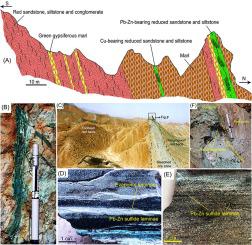当前位置:
X-MOL 学术
›
Ore Geol. Rev.
›
论文详情
Our official English website, www.x-mol.net, welcomes your feedback! (Note: you will need to create a separate account there.)
Temporal–spatial distribution of sediment-hosted stratabound copper deposits in Iran; Implications for future exploration
Ore Geology Reviews ( IF 3.3 ) Pub Date : 2020-12-01 , DOI: 10.1016/j.oregeorev.2020.103834 Sajjad Maghfouri , Ebrahim Rastad , Gregor Borg , Mohammad Reza Hosseinzadeh , Mehdi Movahednia , Amir Mahdavi , Fardin Mousivand
Ore Geology Reviews ( IF 3.3 ) Pub Date : 2020-12-01 , DOI: 10.1016/j.oregeorev.2020.103834 Sajjad Maghfouri , Ebrahim Rastad , Gregor Borg , Mohammad Reza Hosseinzadeh , Mehdi Movahednia , Amir Mahdavi , Fardin Mousivand

|
Abstract Iran is hosting to numerous sediment-hosted stratabound copper (SSC-type) deposits/occurrences. The major structural zones of Iran that host SSC-type deposits are: (1) the Zagros zone, (2) the Tabas Block, (3) the Central Iranian geological and structural gradual zone (CIGS), (4) the Sabzevar zone, and (5) the Kopeh Dagh zone. The SSC-type deposits formed during discrete time periods and in Iran mostly comprise: (1) the Early Cambrian-Ordovician (with the Dehmadan and Khongah deposits in the Zagros zone), (2) the Permian (with the Ghareh Tapeh deposit in the CIGS), (3) the Upper Jurassic (that include Cu mineralizations in the Garedu Red Bed Formation of the Ravar-Tabas-Eshghabad area (RTEA)), (4) the Upper Jurassic to Lower Cretaceous (with SSC mineralization in the Shurijeh Formation of the Kopeh Dagh zone), (5) the Oligocene to Miocene (including the Bande-Gheychi deposit, the SSC deposits of the Boustanabad-Tabriz-Tasuj area, Avaj-Dozkand-Moshampa area and the Torbat-e-Heidarieh SSC-type deposits), and finally (6) the Pliocene (with the Ghareh Aghaj deposit in the CIGS). Extensional basins that have passed through phases of continental rifting and post-collisional extension are the principal plate tectonic setting for the Iranian SSC-type deposits. All of the SSC-type deposits in the Jurassic and Oligocene-Miocene clastic sedimentary rock sequences formed within continental rifts and post-collisional extension settings, respectively, that developed during subduction of the Neo-Tethyan crust beneath the Iranian plate. Intra continental back-arc spreading settings are recognized in the Paleo-Tethys domain in Iran, and these host Cu-bearing dolomitic host rocks (Dehmadan and Khongah area) in the Zagros zone. The stratigraphic sequences of Iranian SSC-type deposits commonly formed from clastic continental red beds, evaporites and limestone, which are similar to other sediment-hosted stratabound copper districts around the world. The copper mineralization is generally closely related to plant fossils (e.g. wood fragments) and the main ore minerals include chalcocite, chalcopyrite, bornite, pyrite, galena, sphalerite, covellite and chrysocolla, the latter two generally have supergene origin. Copper sulfides occur mainly as replacement of diagenetic pyrite, which in turn, replaced organic matter (e.g. wood fragments). Copper mineralization is mainly controlled by the organic matter content and paleo-permeability from intragranular pore space, evaporate layers and brittle fractures. The paleo-permeability has locally been enhanced by calcite dissolution of diagenetic cements. The main period formation of SSC-type mineralization in Iran is from the Jurassic to Miocene. The Tabas Block and CIGS zone are the most promising metallogenic provinces in Iran for SSC-type exploration, because these domains have the greatest abundance and the largest of these copper deposits. These include the Markasheh deposit in the Tabas Block and substantial copper mineralization in the Miocene Red Bed sequence of the Boustanabad-Tabriz-Tasuj and Avaj-Dozkand-Moshampa regions in the CIGS.
中文翻译:

伊朗沉积层状铜矿床的时空分布;对未来探索的影响
摘要 伊朗拥有大量沉积层状铜(SSC 型)矿床/矿床。伊朗拥有 SSC 型矿床的主要构造带是:(1) Zagros 带,(2) Tabas 区块,(3) 伊朗中部地质和构造渐变带 (CIGS),(4) Sabzevar 带, (5) Kopeh Dagh 区。在离散时期和伊朗形成的 SSC 型矿床主要包括:(1)早寒武世-奥陶世(在 Zagros 带 Dehmadan 和 Khongah 矿床),(2)二叠纪(在CIGS),(3) 上侏罗统(包括 Ravar-Tabas-Eshghabad 地区 (RTEA) Garedu 红层组中的铜矿化),(4) 上侏罗统至下白垩统(在 Shurijeh 组有 SSC 矿化) Kopeh Dagh 区),(5) 渐新世至中新世(包括 Bande-Gheychi 矿床、Boustanabad-Tabriz-Tasuj 地区、Avaj-Dozkand-Moshampa 地区的 SSC 矿床和 Torbat-e-Heidarieh SSC 型矿床),最后(6 )上新世(CIGS 中的 Ghareh Aghaj 矿床)。经历大陆裂谷和碰撞后伸展阶段的伸展盆地是伊朗 SSC 型矿床的主要板块构造环境。侏罗纪和渐新世-中新世碎屑沉积岩序列中的所有 SSC 型矿床分别形成于大陆裂谷和碰撞后伸展环境中,这些沉积岩是在伊朗板块下方的新特提斯地壳俯冲过程中形成的。在伊朗的古特提斯域中,大陆内弧后扩张环境得到认可,这些在 Zagros 地区拥有含铜的白云质主岩(Dehmadan 和 Khongah 地区)。伊朗 SSC 型矿床的地层序列通常由碎屑大陆红层、蒸发岩和石灰岩形成,与世界上其他沉积层状铜矿区相似。铜矿化一般与植物化石(如木屑)密切相关,主要的矿石矿物有辉铜矿、黄铜矿、斑铜矿、黄铁矿、方铅矿、闪锌矿、铜锌矿和金钴矿,后两者一般具有表生成因。硫化铜主要作为成岩黄铁矿的替代物出现,而后者又替代了有机物(例如木材碎片)。铜矿化主要受粒内孔隙的有机质含量和古渗透率控制,蒸发层和脆性断裂。成岩胶结物的方解石溶解局部增强了古渗透率。伊朗SSC型矿化的主要形成时期为侏罗纪至中新世。Tabas Block 和 CIGS 带是伊朗最有希望进行 SSC 型勘探的成矿区,因为这些区域拥有最大的丰度和最大的铜矿床。其中包括塔巴斯区块的 Markasheh 矿床和 CIGS 中 Boustanabad-Tabriz-Tasuj 和 Avaj-Dozkand-Moshampa 地区的中新世红层序列中的大量铜矿化。Tabas Block 和 CIGS 带是伊朗最有希望进行 SSC 型勘探的成矿区,因为这些区域拥有最大的丰度和最大的铜矿床。其中包括塔巴斯区块的 Markasheh 矿床和 CIGS 中 Boustanabad-Tabriz-Tasuj 和 Avaj-Dozkand-Moshampa 地区的中新世红层序列中的大量铜矿化。Tabas Block 和 CIGS 带是伊朗最有希望进行 SSC 型勘探的成矿区,因为这些区域拥有最大的丰度和最大的铜矿床。其中包括塔巴斯区块的 Markasheh 矿床和 CIGS 中 Boustanabad-Tabriz-Tasuj 和 Avaj-Dozkand-Moshampa 地区的中新世红层序列中的大量铜矿化。
更新日期:2020-12-01
中文翻译:

伊朗沉积层状铜矿床的时空分布;对未来探索的影响
摘要 伊朗拥有大量沉积层状铜(SSC 型)矿床/矿床。伊朗拥有 SSC 型矿床的主要构造带是:(1) Zagros 带,(2) Tabas 区块,(3) 伊朗中部地质和构造渐变带 (CIGS),(4) Sabzevar 带, (5) Kopeh Dagh 区。在离散时期和伊朗形成的 SSC 型矿床主要包括:(1)早寒武世-奥陶世(在 Zagros 带 Dehmadan 和 Khongah 矿床),(2)二叠纪(在CIGS),(3) 上侏罗统(包括 Ravar-Tabas-Eshghabad 地区 (RTEA) Garedu 红层组中的铜矿化),(4) 上侏罗统至下白垩统(在 Shurijeh 组有 SSC 矿化) Kopeh Dagh 区),(5) 渐新世至中新世(包括 Bande-Gheychi 矿床、Boustanabad-Tabriz-Tasuj 地区、Avaj-Dozkand-Moshampa 地区的 SSC 矿床和 Torbat-e-Heidarieh SSC 型矿床),最后(6 )上新世(CIGS 中的 Ghareh Aghaj 矿床)。经历大陆裂谷和碰撞后伸展阶段的伸展盆地是伊朗 SSC 型矿床的主要板块构造环境。侏罗纪和渐新世-中新世碎屑沉积岩序列中的所有 SSC 型矿床分别形成于大陆裂谷和碰撞后伸展环境中,这些沉积岩是在伊朗板块下方的新特提斯地壳俯冲过程中形成的。在伊朗的古特提斯域中,大陆内弧后扩张环境得到认可,这些在 Zagros 地区拥有含铜的白云质主岩(Dehmadan 和 Khongah 地区)。伊朗 SSC 型矿床的地层序列通常由碎屑大陆红层、蒸发岩和石灰岩形成,与世界上其他沉积层状铜矿区相似。铜矿化一般与植物化石(如木屑)密切相关,主要的矿石矿物有辉铜矿、黄铜矿、斑铜矿、黄铁矿、方铅矿、闪锌矿、铜锌矿和金钴矿,后两者一般具有表生成因。硫化铜主要作为成岩黄铁矿的替代物出现,而后者又替代了有机物(例如木材碎片)。铜矿化主要受粒内孔隙的有机质含量和古渗透率控制,蒸发层和脆性断裂。成岩胶结物的方解石溶解局部增强了古渗透率。伊朗SSC型矿化的主要形成时期为侏罗纪至中新世。Tabas Block 和 CIGS 带是伊朗最有希望进行 SSC 型勘探的成矿区,因为这些区域拥有最大的丰度和最大的铜矿床。其中包括塔巴斯区块的 Markasheh 矿床和 CIGS 中 Boustanabad-Tabriz-Tasuj 和 Avaj-Dozkand-Moshampa 地区的中新世红层序列中的大量铜矿化。Tabas Block 和 CIGS 带是伊朗最有希望进行 SSC 型勘探的成矿区,因为这些区域拥有最大的丰度和最大的铜矿床。其中包括塔巴斯区块的 Markasheh 矿床和 CIGS 中 Boustanabad-Tabriz-Tasuj 和 Avaj-Dozkand-Moshampa 地区的中新世红层序列中的大量铜矿化。Tabas Block 和 CIGS 带是伊朗最有希望进行 SSC 型勘探的成矿区,因为这些区域拥有最大的丰度和最大的铜矿床。其中包括塔巴斯区块的 Markasheh 矿床和 CIGS 中 Boustanabad-Tabriz-Tasuj 和 Avaj-Dozkand-Moshampa 地区的中新世红层序列中的大量铜矿化。



























 京公网安备 11010802027423号
京公网安备 11010802027423号